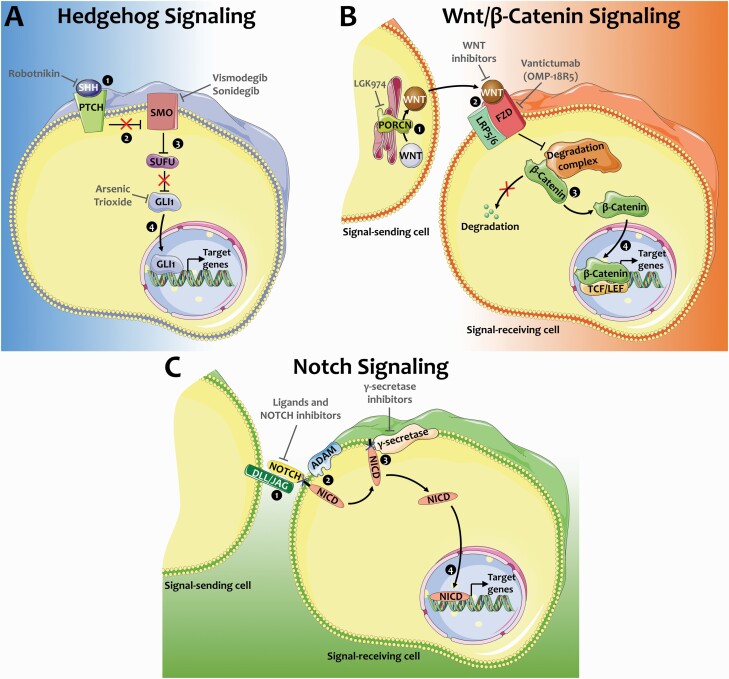Figure 2.
Signaling pathways targeted in cancer therapies. Hedgehog, Wnt/β-catenin, and Notch signaling are developmental pathways that are activated in multiple forms of cancer, rendering them promising therapeutic targets. (A) Hedgehog signaling pathway. In the absence of SHH, PTCH receptor inhibits SMO. SUFU sequesters GLI1 in the cytoplasm resulting in inactive Hh signaling. SHH binding to PTCH receptor ① lifts its inhibition of SMO ②. Activated SMO sequesters SUFU ③, resulting in translocation of GLI1 to the nucleus ④ and transcription of target genes. Targeted cancer therapeutics include Robotnikin that binds and inhibits SHH, SMO inhibitors Vismodegib and Sonidegib, and GLI1 inhibitor arsenic trioxide. (B) Wnt/β-catenin signaling pathway. PORCN palmitoylates WNTs in the endoplasmic reticulum of signal-sending cells ①. Secreted WNTs bind to FZD/LRP receptor complex on the surface of signal-receiving cells ②, resulting in dismantling of the degradation complex and release of β-catenin rather than its degradation ③. β-catenin then translocated to the nucleus and binds to T-cell factor/lymphoid enhancer factor (TCF/LEF) transcription factors to induce the transcription of target genes ④. Anticancer drug LGK974 averts the activation of WNTs via inhibition of PORCN, while WNT inhibitors prevent binding to the receptors and vantictumab inhibits FZD proteins. (C) Notch signaling pathway. Interaction of delta-like (DLL) and jagged (JAG) ligands present on the surface of signal-sending cells with NOTCH receptors anchored in the membrane of signal-receiving cells ① results in extracellular S2 site cleavage by ADAM metalloproteases ②. Subsequent intramembrane S3 site cleavage by γ-secretases releases Notch intracellular domain (NICD) ③ that translocates to the nucleus and activates the transcription of target genes ④. Anticancer therapeutics have been developed to inhibit Notch ligands and receptors, as well as γ-secretases. Illustrations are modified from Servier Medical Art licensed under a Creative Commons Attribution 3.0 Unported License (https://smart.servier.com/).

